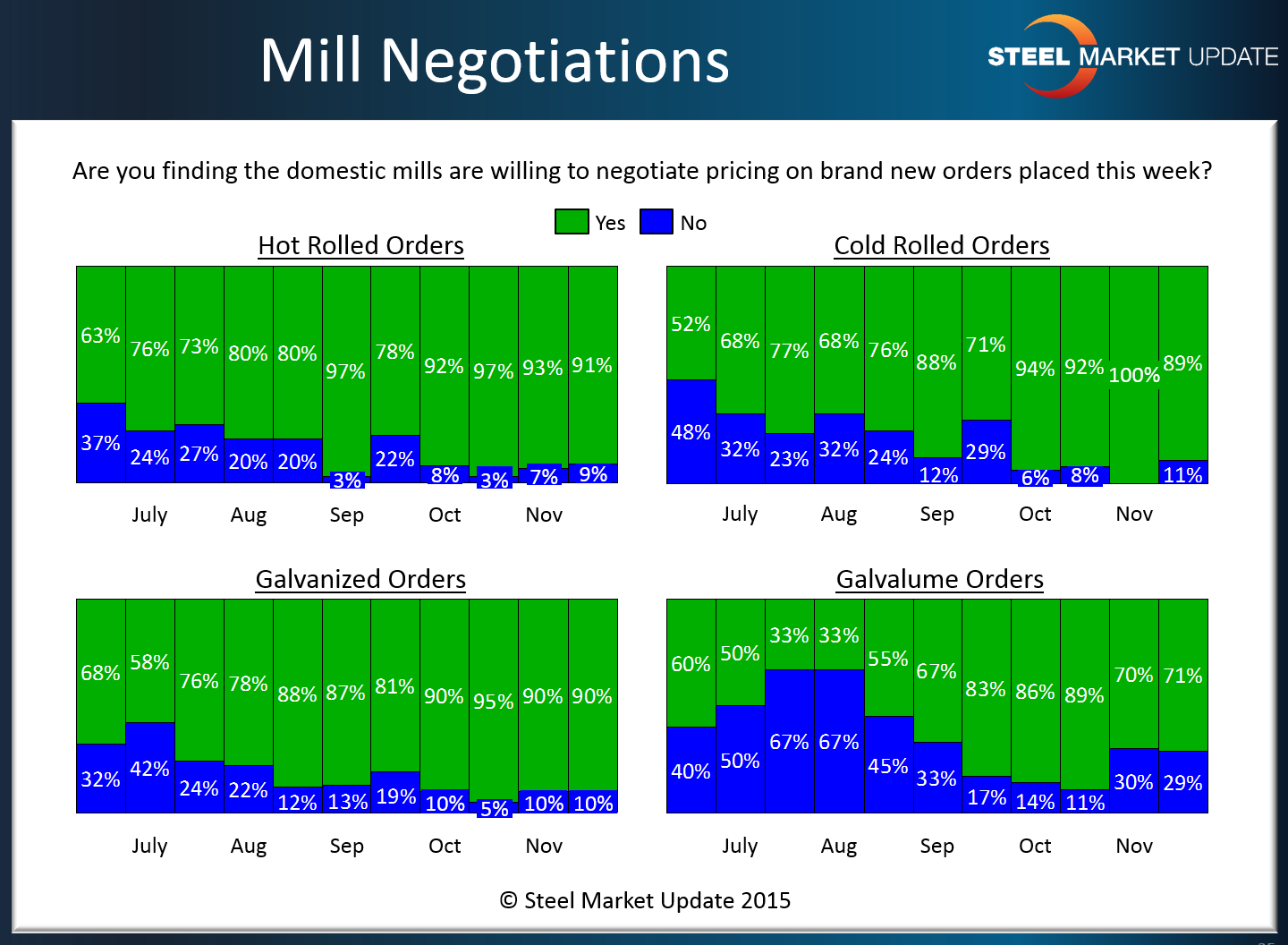SMU Data and Models

Domestic Mill Steel Price Negotiations: Everybody’s Still Talking…
Written by John Packard
November 19, 2015
Based on the results of this week’s flat rolled steel market analysis (survey) conducted by Steel Market Update (SMU) the flat rolled steel mills continue to aggressively pursue orders by negotiating spot prices on hot rolled, cold rolled, galvanized and to a slightly lesser extent, Galvalume.
As you can see by the graphic shown below, 91 percent of those responding to our questionnaire reported the domestic mills as willing to discuss hot rolled prices. This is essentially in line and unchanged from what we gathered at the beginning of this month and just slightly lower than the 97 percent reported one month ago.
Cold rolled products saw a slight decrease in those reporting the domestic mills as willing to negotiate CR prices. Eighty-nine percent of our respondents reported the mills as willing to negotiate CR pricing. This is down 11 percent compared to two weeks ago but is in line with the data collected during the middle of October.
Our respondents reported that the mills as willing to negotiate with 90 percent of our respondents reporting that way. This is essentially in line with what we have been collecting over the past couple of months.
Seventy-one percent of our respondents reported the domestic mills as willing to negotiate Galvalume prices. This is unchanged from two weeks ago but is well below the high 80’s that we were collecting during September through the middle of October.
A side note: The data for both lead times and negotiations comes from only service center and manufacturer respondents. We do not include commentary from the steel mills, trading companies or toll processors in this particular group of questions.
To see an interactive history of our Steel Mill Negotiations data, visit our website here.

John Packard
Read more from John PackardLatest in SMU Data and Models

SMU Scrap Survey: Sentiment Indices rise
Both current and future scrap sentiment jumped this month, though survey participants reported responses before key trade news was announced.

SMU Survey: Sentiment splits, buyers have better view of future than the present
SMU’s Steel Buyers’ Sentiment Indices moved in opposite directions this week. After rebounding from a near five-year low in late June, Current Sentiment slipped again. At the same time, Future Sentiment climbed to a four-month high. Both indices continue to show optimism among buyers about their company’s chances for success, but suggest there is less confidence in that optimism than earlier in the year.

SMU scrap market survey results now available
SMU’s ferrous scrap market survey results are now available on our website to all premium members. After logging in at steelmarketupdate.com, visit the pricing and analysis tab and look under the “survey results” section for “ferrous scrap survey” results. Past scrap survey results are also available under that selection. If you need help accessing the survey results […]

SMU flat-rolled market survey results now available
SMU’s latest steel buyers market survey results are now available on our website to all premium members. After logging in at steelmarketupdate.com, visit the pricing and analysis tab and look under the “survey results” section for “latest survey results.” Past survey results are also available under that selection. If you need help accessing the survey results, or if […]

SMU Survey: Sheet lead times stabilize, plate contracts
Mill lead times for sheet products were steady to slightly longer this week compared to our late June market check, while plate lead times contracted, according to steel buyers responding to this week’s market survey.

